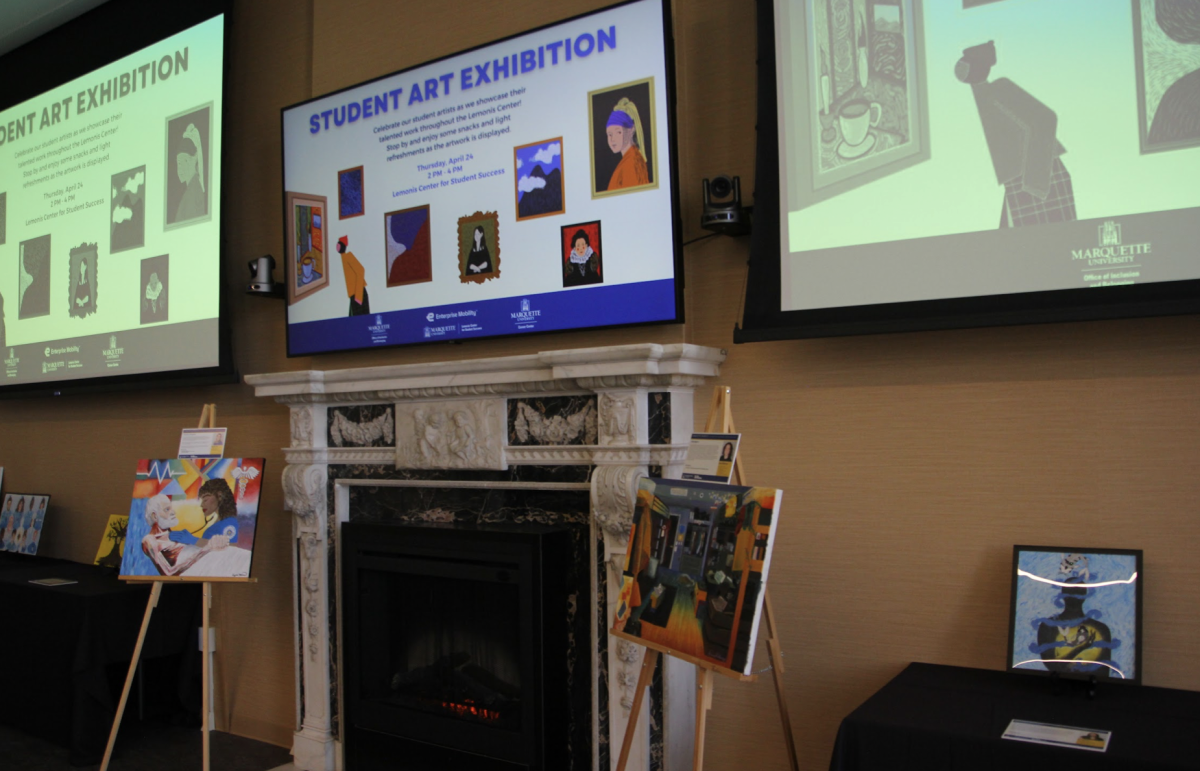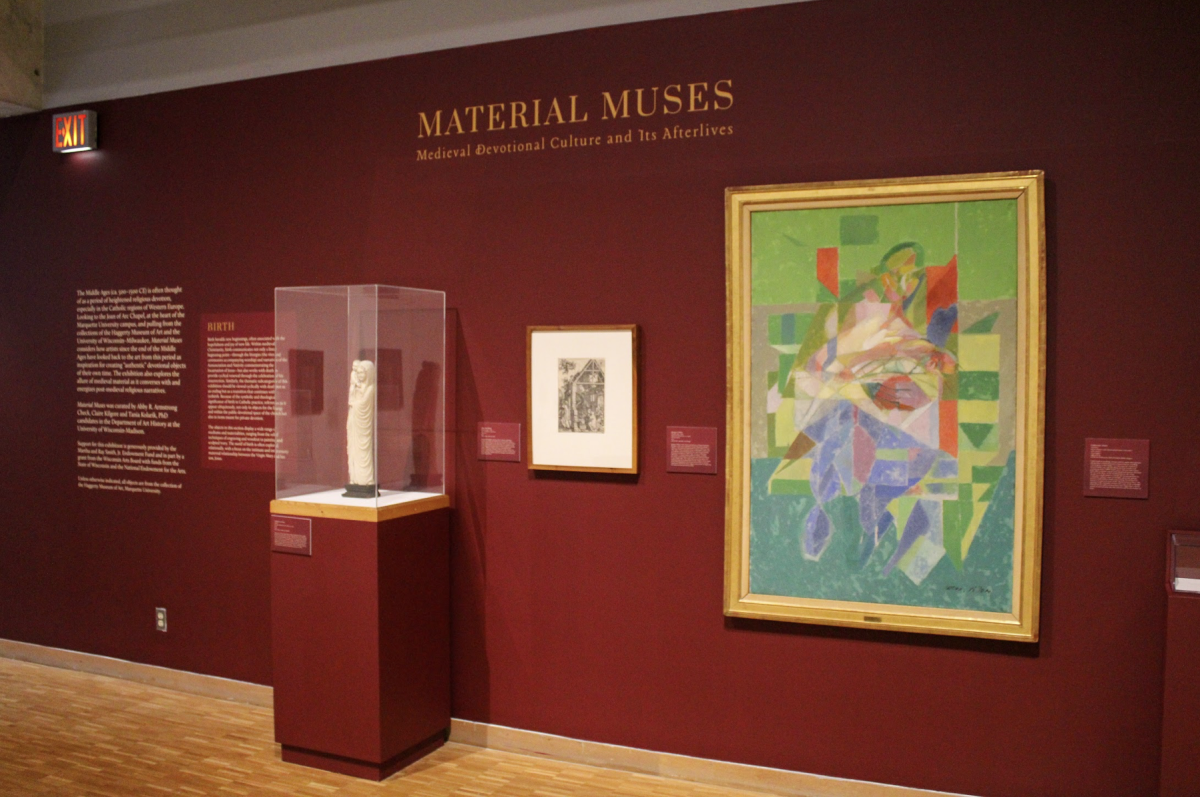
Before displaying any artwork to the public eye, all museums want to ensure each piece is in the best possible condition. The Haggerty Museum of Art has a remarkable permanent collection of more than 4,500 works of art, but not all of them are in perfect shape.
Prior to the museum’s opening in 1984, many of these pieces were dispersed all over Marquette’s campus. They may have been hung in the library, offices or classrooms — quite different environments from the clean, climate-controlled space of a museum. All pieces of art age, but in these locations, the works were also susceptible to dirt and damage.
Wally Mason, director of the Haggerty, has been committed to restoring artwork to its rightful condition by making the conservation process a high priority for the museum. He said that he wants to share all the works the Haggerty has to offer, but it is most important that the pieces are in a condition that allows people to see them the way the artist intended.
“It is essential to not just let these things go by the wayside,” Mason said. “We’re motivated to get them taken care of and then to be able to share them with our audience.”
Since the Haggerty does not have a conservator on staff, the museum enlists the help of private conservators to make its artwork exhibition-ready. In 2008, conservator Barry Bauman conducted a government-funded conservation assessment for the museum.
“When he came up to do a site visit, we really connected with him,” Mason said.
Bauman received his bachelor’s degree from Beloit College in 1969 and his master’s degree in art history from the University of Chicago in 1971. In 1972, he joined the conservation department at the Art Institute of Chicago and agreed to stay on for at least 10 years of training. Eleven years later, in 1983, he left as the associate conservator of paintings and founded the Chicago Conservation Center as a resource facility for the conservation of paintings and various other art mediums.
His business grew to become the largest private conservation facility in America. But after 20 years of ownership, Bauman was ready to move on. Selling the Conservation Center in August 2003, he established Barry Bauman Conservation, the first national conservation laboratory in the United States dedicated to providing complimentary restoration services to museums and non-profit organizations.
“I had already been successful in running a business,” Bauman said. “So I thought, I would like to work exclusively for museums and to have an opportunity to work on better paintings.”
He has forged strong relationships with many museums, and since his assessment at the Haggerty, Bauman has done conservation work on 20 of its paintings pro bono.

“He is absolutely fabulous,” Mason said. “He is very thoughtful, and we have a good working relationship with him.”
Working seven days a week, Bauman has a turnover time of about 16 weeks per work and treats about 100 paintings a year. He is extremely experienced and has built up a great reputation as a conservator of paintings.
“At this point, it’s not work,” Bauman said. “It’s just reward. It’s just fun.”
According to Mason, choosing which pieces to restore and when is a collaborative effort between museum staff and Bauman. Mason said the selection process has to do with both preparation for future exhibitions and a bit of personal preference. Ultimately, though, it is about restoring the artwork to its original appearance.
One of the more significant restorations Bauman did for the Haggerty was on an 1884 portrait of William Cramer by artist G.P.A. Healy. Cramer was married to Harriett Barker Cramer, an early Marquette donor and the namesake of Cramer Hall.
According to John Loscuito, registrar at the Haggerty, the piece was in poor condition before Bauman began work on it, with extremely yellowed varnish and a hole in the canvas.
“I think the Healy was the most impressive,” Loscuito said, “but there are a variety of others that he has worked on that have been really great.”
The varnish, a clear protective coat of paint applied over a finished painting, is the element that changes most dramatically over time. As the varnish ages, the painting becomes increasingly yellow and dark. When this happens, the original intent of the artist is lost, and it is up to conservators like Bauman to bring it back.
“If you look at a painting and you see yellow clouds, yellow sheep, yellow lace, green skies or green water, you are not looking at what the artist originally intended,” Bauman said.
Bauman begins the typical conservation process on an old master painting by taking a pre-treatment photo. This is both for a historical purpose, documenting the existing condition of the piece, and for liability concerns.
He then takes another photo, but this time in ultraviolet light, which allows him to see the restoration history of the piece. When shot in this light, the varnish appears to be green. If it has been painted over in a previous restoration, those spots will show up as black.
Bauman also uses infrared analysis, which reveals where there may be nail holes or tears in the canvas.
“Using infrared allows us to see areas that our eyes can’t see,” Bauman said.
When Bauman has a feel for the condition of the painting he’s working with, he begins the cleaning process. Here, art meets science as a chemical solution is used to remove old varnish, dirt and previous restorative elements. Older paintings sometimes have two or three different layers of varnish on them, which conservators take off one by one.
“We get down to the original layer, and only the original layer,” Bauman said.
This is the most important step in the process because the conservator is able to see everything as it was initially painted. Once this is done, Bauman usually adds another canvas on the back of the painting for support. Many museums request this step if they send their paintings out on loan.
When the lining is complete, Bauman often restretches the painting onto a spring-stretcher that offers constant and even tension, which prevents the canvas from warping. After that, he moves on to the varnishing stage, where he applies a non-yellowing varnish so he can perform retouching on the top layer rather than the original piece. This way, his paint can easily be taken off and the artist’s original work is not harmed.
After the varnish dries, the piece is ready to be displayed. In the case of the Healy painting, the Haggerty now has a masterpiece that it can finally show off instead of a yellowed, holey canvas with a picture on it.
“I think events like that really instill a pride for the Haggerty staff and hopefully for the university, that what we have is worth taking care of and spending time with,” Loscuito said.





